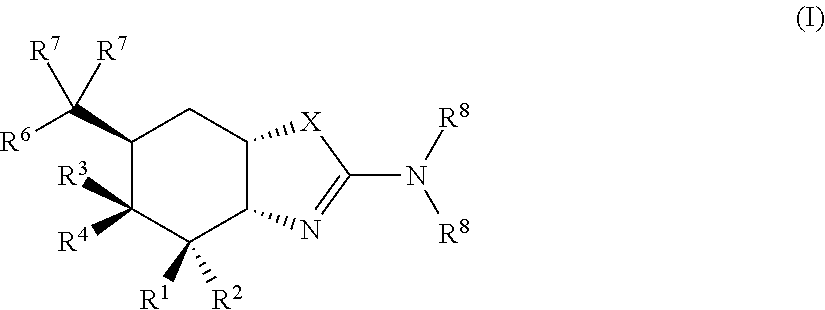Selective glycosidase inhibitors and uses thereof
a glycosidase inhibitor and selective technology, applied in the field of selective glycosidase inhibitors, can solve the problems of complex use of non-selective inhibitors in studying the physiological role of cellular and organismal enzymes, hyperphosphorylation of tau, and disruption of normal functions of tau, so as to achieve enhanced permeability
- Summary
- Abstract
- Description
- Claims
- Application Information
AI Technical Summary
Benefits of technology
Problems solved by technology
Method used
Image
Examples
example 1
(3aR,4R,5R,6S,7aS)-2-(Ethylamino)-6-(fluoromethyl)-3a,4,5,6,7,7a-hexahydrobenzo[d]oxazole-4,5-diol
[0158]
[0159]To a solution of rac-((((1R,2R,6R)-6-((benzyloxy)methyl)cyclohex-3-ene-1,2-diyl)bis-(oxy))bis(methylene))dibenzene (Carb. Res., 1990, 204, 51-64; Carb. Res., 1990, 206, 352-60) (3.71 g, 9.02 mmol) in DMSO (40 mL) and water (0.487 mL, 27.1 mmol) at 10° C. was added freshly recrystallised NBS (3.21 g, 18.04 mmol) in one portion. The mixture (which slowly became a yellow solution) was stirred at room temperature for 2.5 h. The reaction was diluted with aqueous satd. NaHCO3 (300 mL) and extracted with EtOAc (2×150 mL). The combined extracts were washed with brine and dried over MgSO4. Solvents were evaporated under reduced pressure. The residue was purified by silica gel column chromatography, eluted with 20-30% EtOAc in hexanes to give a mixture of rac-(1S,2R,3S,4R,5R)-3,4-bis(benzyloxy)-5-((benzyloxy)methyl)-2-bromocyclohexanol and a diastereomeric side-product in a 9:1 ratio,...
example 4
(3aR,4R,5R,6S,7aS)-2-(azetidin-1-yl)-6-(fluoromethyl)-3a,4,5,6,7,7a-hexahydrobenzo[d]oxazole-4,5-diol
[0170]
[0171]To a solution of (3aS,4R,5R,6S,7aS)-4,5-bis(benzyloxy)-6-(fluoromethyl)hexahydrobenzo[d]oxazol-2(3H)-one (193 mg, 0.503 mmol) in DCM (4 mL) at room temperature was added 4 A molecular sieves (130 mg) followed by trimethyloxonium tetrafluoroborate (372 mg, 2.52 mmol). The mixture was stirred at room temperature under N2 for 24 h. Azetidine hydrochloride (236 mg, 2.52 mmol) and a solution of Et3N (279 mg) in THF (2.0 mL) was added. The mixture was stirred at room temperature for another 48 h. The reaction was diluted with saturated aqueous NaHCO3 (20 mL) and extracted with DCM (2×15 mL). The extracts were dried with Na2SO4 and the solvents were evaporated to give the crude product. This was purified by silica gel column, eluted with 2%-5% 2 M NH3 MeOH solution in DCM to yield (3aS,4R,5R,6S,7aS)-2-(azetidin-1-yl)-4,5-bis(benzyloxy)-6-(fluoromethyl)-3a,4,5,6,7,7a-hexahydroben...
example 6
(3aR,4R,5R,6S,7aS)-2-(azetidin-1-yl)-6-(difluoromethyl)-3a,4,5,6,7,7a-hexahydrobenzo[d]oxazole-4,5-diol
[0174]
[0175]To a solution of (3aR,4R,5R,6R,7aS)-4,5-dihydroxy-6-(hydroxymethyl)hexahydrobenzo[d]oxazol-2(3H)-one (2.23 g, 11.0 mmol) in DMF (15 mL) at room temperature was added imidazole (2.24 g, 33.0 mmol) followed by TBDMSCl (1.98 g, 13.2 mmol). The mixture was stirred at this temperature for 2.5 h. The mixture was diluted with water (150 mL) and extracted with EtOAc (5×50 mL). The extracts were dried with MgSO4 and the solvents were evaporated. The crude product was purified by silica gel column chromatography, eluted with 5% MeOH in DCM to give the product (3aR,4R,5R,6R,7aS)-6-(((tert-butyldimethylsilyl)oxy)methyl)-4,5-dihydroxyhexahydrobenzo[d]oxazol-2(3H)-one (2.57 g, 74%) as a white solid. 1H NMR (400 MHz, MeOD) δ 4.68-4.71 (m, 1H), 3.85 (dd, J=8.0 Hz, 3.2 Hz, 1H), 3.63 (dd, J=8.0 Hz, 5.2 Hz, 1H), 3.47-3.55 (m, 2H), 3.37 (t, J=7.8 Hz, 1H), 2.14 (dt, J=12.5 Hz, 2.3 Hz, 1H), ...
PUM
| Property | Measurement | Unit |
|---|---|---|
| temperature | aaaaa | aaaaa |
| temperature | aaaaa | aaaaa |
| temperature | aaaaa | aaaaa |
Abstract
Description
Claims
Application Information
 Login to View More
Login to View More - Generate Ideas
- Intellectual Property
- Life Sciences
- Materials
- Tech Scout
- Unparalleled Data Quality
- Higher Quality Content
- 60% Fewer Hallucinations
Browse by: Latest US Patents, China's latest patents, Technical Efficacy Thesaurus, Application Domain, Technology Topic, Popular Technical Reports.
© 2025 PatSnap. All rights reserved.Legal|Privacy policy|Modern Slavery Act Transparency Statement|Sitemap|About US| Contact US: help@patsnap.com



